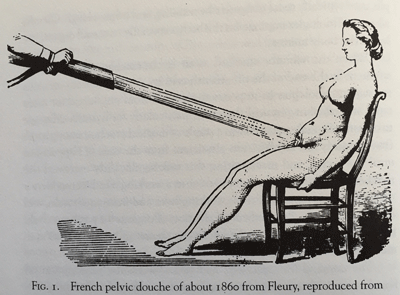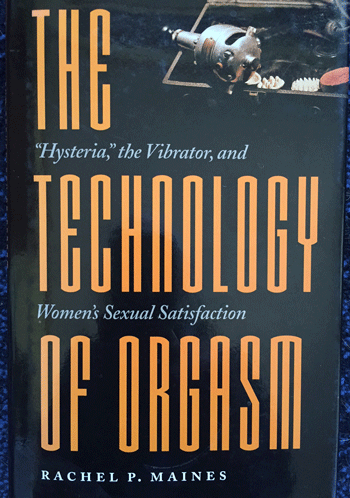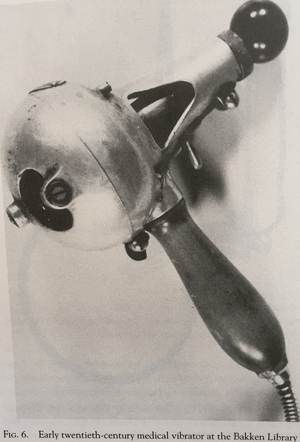The orgasmic solution to a made-up medical woe
by MICHAEL BRAUNSTEIN
Online 2015.02.03
Just over 100 years ago, the most common cause for a woman to visit her family physician was a bad case of hysteria, a scourge once common in the 1800s that struck women of child-bearing years, married or single, young or old. Hysteria was officially a female illness and by the 1890s, these patients comprised a significant proportion of many a physician’s practice.
Most of us understand the word “hysterical” in its more modern sense. We take it to mean the idea of something uncontrollably funny or absurd or emotional to the extent of upset. That’s only the recent connotation.
Literally translated from the Latin, hysteria means “out of the uterus.” For centuries, medically speaking, hysteria meant “womb disease.” As described by Hippocrates, Avicenna, Galen, and Celsus in the classical period and Freud, Charcot and others in modern times, hysteria was a woman’s disease. Hysterical women displayed irritability, anxiety, sleeplessness, nervousness, sensations of heaviness in the abdomen, lower pelvic edema and erotic fantasy. Throughout history, doctors relied on but one cure for hysteria. The technical term for this cure was “uterine paroxysm,” literally a contraction of the uterus. Uterine paroxysm left women relaxed and serene.
Come now! By any other name, a uterine contraction or paroxysm is known as an orgasm. That’s right. Hysteria was the disease. Orgasm was the cure.
Medicine is typically clinical and sterile. Though medicine refrained from officially relating “uterine paroxysm” to sex, many medical recommendations referred bluntly to having hysterical women go home and have the “husband take care of her.” In short, throughout the history of medical practice, female hysteria was thought to be the result of sexual deprivation. It wasn’t until 1952 that the American Psychiatric Association officially removed hysteroneurosthenic disorders from its list of modern disease paradigms.
Get a buzz on. Author Rachel P. Maines documented this bizarre outlook on female sexuality and the strange practice of medicine common in the past. In The Technology of Orgasm –  ‘Hysteria’, the Vibrator and Women’s Sexual Satisfaction, Maines provides a detailed look at an astonishing and androcentric view of sexuality, health and technology.
‘Hysteria’, the Vibrator and Women’s Sexual Satisfaction, Maines provides a detailed look at an astonishing and androcentric view of sexuality, health and technology.
As absurd as this whole thing sounds, by the 1890s a diagnosis of hysteria brought millions of women (and dollars) to doctors for a cure. The treatment performed by the doctor in his office was manual massage of the female genitalia until “paroxysm” was reached. Doctors complained that sometimes that took upwards of an hour. Many docs could remove an appendix faster than they could give a patient a “paroxysm.” But when accomplished, relief was nearly 100 percent — until the next time the patient became “hysterical.” (Certainly there were other types of “hysteria” that were pathological or psychological disorders similar to severe mental illness that would institutionalize someone today.)
A large part of a physician’s practice in the late nineteenth century was made up of hysterical women. Maines notes that there is no evidence that the doctors enjoyed their work of giving women orgasms. In fact, quite the contrary according to Maines. Doctors often lacked the patience or interest to spend the required time with patients to give them relief from hysteria. Assistants, nurses and office staff were enlisted to perform what doctors (and many husbands of the period) saw as a tedious task.
Enter technology. As Maines writes, doctors wanted to provide their hysterical patients with relief but not at the cost of the time and skill required. They resorted to various methods to speed the process and relieve themselves of the work. One early method used a stream of water to do the massaging. Hydriatic massage, as it was called, was successful but required considerable office modification and was messy. Mechanical devices using treadle power, spring power and even steam power were developed to provide a consistent vibration to the desired area of the body. Massage was therapeutic for other ailments besides hysteria, but doctors found the vibrating massage was perfect for producing orgasm – er, — “uterine paroxysm.” One steam powered device had a vibrating mechanism suspended beneath a therapy table with the operative attachment protruding through an opening where the patient would place the pelvic region. Most of these early vibrating devices were awkward and required a capital investment that even a large patient-base of hysterical women couldn’t justify.
But in 1880, British physician Joseph Granville developed a battery-operated electromechanical device that was easy to use and effective. There was a selection of “vibratodes” that allowed it to be used for any number of therapeutic purposes.  Derivations of Granville’s invention became standard equipment in clinics throughout the Western hemisphere. Medical exhibits at the Paris Expo in 1900 displayed over a dozen therapeutic vibrators. Ads, articles and textbooks published around the turn of the century extolled the vibrator’s time-saving and labor-saving qualities, especially for gynecological massage.
Derivations of Granville’s invention became standard equipment in clinics throughout the Western hemisphere. Medical exhibits at the Paris Expo in 1900 displayed over a dozen therapeutic vibrators. Ads, articles and textbooks published around the turn of the century extolled the vibrator’s time-saving and labor-saving qualities, especially for gynecological massage.
There was a vibrational revolution going on and doctors were getting exactly what they wanted: relief from a job they didn’t want to do. Like mechanics at a garage, they could reach up toward the ceiling of their office and pull down an electrical device suspended by a wire, select the appropriate attachment and finish their treatment in one-tenth the time. Or they could place their patient on a therapy table, face-down, plug in the vibrating portion of the device and come back 15 minutes later to a “beaming, healthy, radiant patient, no longer hysterical but energized and vital,” just as ads in the professional journals promised.
By 1910, the electric vibrator was being marketed as a home appliance in family periodicals, with ads in such respected magazines as Modern Women, McClure’s, Needlecraft, and Modern Priscilla. Price dropped and technology advanced, devices were simpler and a funny thing happened. Fewer women made that trip to the doctor’s office for treatment. Medicine had looked at women’s sexual frustration, men’s negligence or ignorance in contributing to it and labeled it a disease. Then technology placed the cure in the hands of women everywhere.
Modern medicine and technology had found a cure for the disease that wasn’t a disease. And it was available to women everywhere.
Be well.
